Freelance Digital Marketing - The Ultimate Guide
Chapter 6:
Scaling - How To Grow Your Freelance Marketing Business

If you’ve made it this far, congratulations, because at this stage you should be well on your way to having a full-fledged freelance digital marketing business.
In the last five chapters of this Ultimate Guide you've learned how to pick your freelance marketing niche, how to get new clients, how to run your business like a pro, and strategies to retain your clients and keep them happy with your services.
The only thing left to complete your freelance marketing education is to learn how to scale your business!
So in this chapter we're covering everything you need to know to take your business to the next level with practical tips and strategies for scaling your operations.
Are you ready to dive in?
Let’s do this!
Are you new to this guide? If so, here’s a quick overview of all the chapters in this Ultimate Guide To Freelance Digital Marketing:
Freelance Digital Marketing - The Ultimate Guide (Overview)
- How To Choose Your Niche As A Freelance Digital Marketer
- Pricing Strategy - How To Price Your Freelance Marketing Business
- Client Acquisition - How To Get Freelance Marketing Clients
- Operations - How To Manage Your Freelance Marketing Business Like A Pro
- Client Retention - How To Keep Your Clients Happy
- Scaling - How To Grow Your Freelance Marketing Business
What does it mean to scale your freelance business?

The term “scaling” gets thrown around a lot in the online business and entrepreneur spaces, so it’s meaning has become a bit... murky.
In the context of business - and freelancing - scaling essentially means to grow or expand your operations while proportionally growing your profit.
In other words, if you’re growing your operations but not proportionally growing your profits, you’re not scaling.
Scaling a freelance business is no different and comes down to the ability to grow it beyond your personal limitations while remaining profitable.
Freelancers often have trouble growing due to their own personal limitations of time and resources.
Basically, once you reach a certain number of clients on your roster, or hours per week that you are spending on your business, you may hit a ceiling and stall out on growth.
In order to scale any business - even just a solo freelance operation - typically you need to identify any bottlenecks or roadblocks for growth and eliminate them in order to get to the next level.
In this case the main bottleneck is usually the freelancer herself, because she only has so many hours in the day, limited resources, and available mental energy and bandwidth to devote to her clients and work.
So in order to scale she has to remove those limitations... but how does she do it?
That is the central question that we will be addressing in this chapter of the ultimate guide on freelance digital marketing.
So keep reading because this chapter has all the ingredients you need to start growing your revenues and profit.
When is the right time to scale your freelance business?

Figuring out the right time to scale your business is a very personal thing.
There's no formula to this, it comes down to what you want, what your goals are, and the level of ambition and responsibility you're willing to take on in pursuit of growing your business.
Unlike freelance businesses, most traditional businesses are set up from the beginning with the basic mechanisms in place to scale. They're built from the ground up with the infrastructure in place to hire employees and grow beyond their initial stages.
Freelance businesses typically begin with a single person taking on one or more contracts and then hit a tipping point in their business where they suddenly realize that in order to grow they’re going to need to convert the structure of their business into something more traditional.
Signs you’re ready to scale your freelance business:
7 ways to scale your freelance business

In the section we're going to go over 7 powerful ways to scale your freelance business.
You might be a graphic design artist, a social media marketing consultant, or a Facebook ads Guru...
...Whatever your situation, in this section you'll find potential ways to scale up your business and potentially find something that’s the right fit for you.
And it all starts with making a plan.
1. Make a Plan
In order to really scale your freelance business you're going to need to start with a plan of action.
Most businesses will pivot at some point, and for you it may be pivoting into a marketing agency or consultancy, if that's the case then having a plan of action in front of you with clearly defined goals will help you as you confront the realities of your changing business.
Many freelancers simply blunder into becoming a full-blown business owner with employees and payroll and the full nine yards...
But since you're reading this post I'm going to assume you're interested in thinking ahead, so step number one is going to be creating your plan of action.
First you need to ask yourself:
What do you really want?
Do you want to scale into a full-fledged marketing agency with employees, contractors, account managers, billing and payroll (all that goes along with an agency), or do you really want to just expand your current operations to the point where you've got a healthy lifestyle business that is paying for your life with yourself mostly hands off?
Start with the end goal in mind and ask yourself what you really want:
List it all out on a piece of paper or spreadsheet, and start going through the pros and cons of each potential option for scaling your business.
Further along in this chapter we’ll go over ways to scale into an agency, but for now just start with an end goal in mind and ask yourself the big important questions.
A few questions to ask yourself during this phase might be:
Just getting started down the path of thinking about your operations and where gaps can be filled will be a big moment in your business.
2. Pricing (Up your rates)
One of the easiest and fastest ways to scale up your freelancing income is to increase your prices.
It may seem obvious, but many freelancers overlook this simple way to grow their business, or are reluctant to change their prices for fear of their clients reaction.
However, if you’ve grown your business to the point of multiple happy clients who are getting great results, this might be the exact thing you need to grow your income without getting new clients or outsourcing.
What would a 10 - 20% boost in your revenue mean for your business?
With a simple tweak to your pricing you can increase your revenue and profits with very little effort.
But here’s the thing... this move IS NOT for everyone.
If you’re worried about causing issues with clients, then tread carefully - however, you know your clients and your relationships better than us, obviously, so it’s worth sitting down, thinking it through, and getting strategic about it if you plan on moving forward.
Here’s what we suggest considering before moving forward with a pricing change at the very minimum:
Now, after going through this exercise, if you think you have a case with your client to increase your rates, you probably have enough for your conversation with the client.
We recommend you give them at least 4 - 6 weeks advance notice of pricing changes to give them a buffer to plan ahead.
Upping your pricing is a great way to grow your business without bringing on new clients, but it can have its pitfalls, and has the potential to ruin relationships so tread carefully, consult any of your business partners, and have a plan of action in place in case your plan goes wrong.
3. Offer Related Services and Create Your Value Ladder
Have you heard of the concept of a value ladder?
If not, you are missing out on a world of potential profit.
Ask yourself:
Are you only providing one, two, or maybe three services to your client?
Is it possible that there are other complementary products, services, or offers that you can add to your relationship with your current clients to increase the value of those relationships?
The value ladder is a concept that can be applied to any industry which details out a strategy for increasing the lifetime value of your customers.
Here’s an example of a dentists value ladder below:
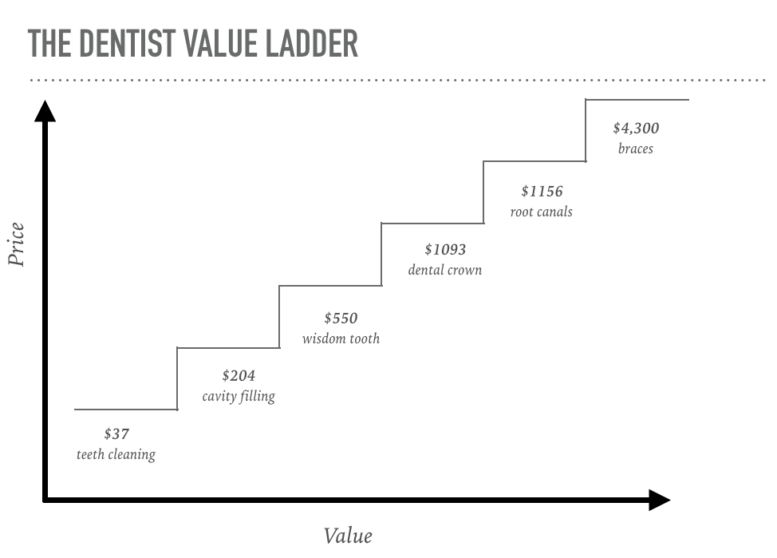
Example of a dentists value ladder. Source: CommunityNewspapers.com
Note that the strategy is to move clients through an ascending “ladder” of increasing cost, from low front-end offers to high-ticket products at the top of the ladder.
The reason this works so well is because as you’re relationship progresses with the client, trust in your relationship also increases, and they’re more likely to invest in that relationship going forward (kaching!).
For a freelance digital marketer, it’s going to look a lot different from a dentist obviously, but the strategy is exactly the same.
Here’s an example of a potential SEO’s value ladder to illustrate how this could work:
- Step 1 - Front-end offer (affordable or free): One-page actionable recommendations for on-page SEO improvements (Free - $99).
- Step 2 - Continuity offer (pays monthly): Ongoing backlinking, on-page SEO improvements, reporting on results ($499/month).
- Step 3 - Create a one-time 3 year SEO strategy, outlook, keyword analysis, and content strategy ($1999).
- Step 4 - Add a new continuity offer for more recurring income: 2X blog posts per month to start implementing the content strategy ($399/month).
- Step 5 - High ticket offer or cross sell: One-time on-site employee training or event coaching, consulting, and operations/process to take place over 5 days ($5,000).
- Step 6 - Final Ascension offer: 1X per year mastermind, retreat, strategic networking event with all expenses included ($10,000 - $100,000 per annual event).
4. Get an Assistant
A virtual assistant is one of the best ways to remove yourself as an obstacle to your own business.
If a ton of repetitive small tasks are starting to build up and taking up all your time then you might be in a perfect position to start scaling your business by bringing on a virtual assistant.
Virtual assistants can be trained to help you with everything from managing your schedule, sorting through your inbox, following up with your clients on payment details, data entry, and a lot more.
So if you find yourself doing things like constantly dumping data into a spreadsheet and constantly chasing down things like emails or messages or constantly fighting with your schedule, a virtual assistant might be exactly what you need.

Image source: makeameme.org
However, VA’s can be a help, or a hindrance.
As with any new employee, VA’s require a lot of training, and you'll typically need to give your new assistant some time to get up to speed and to start really providing value.
One great way to work with virtual assistants is to create standard operating procedures (SOPs), so you can easily hand off a complex task to a new assistant.
An SOP is a document that defines the steps necessary to complete a task or project.
Finding the right virtual assistant can also be a challenge.
Although there are a lot of places online that offer virtual assistants online (which we cover in the next section) you'll still need to sort through them and find the ones that actually have the capability to perform a task that you need.
Here’s a strategy that can help you find the right freelance virtual assistant for you:
- Carefully lay out all the steps and tasks needed to accomplish one impactful job for your business (this will be your SOP). It could be loading up a spreadsheet with data or it could be balancing your books from your accounting software. Write down every step needed to successfully finish the job on a Google Doc or a Microsoft Word Doc. Make sure it's a task that will take a virtual assistant no more than 1 - 3 hours to complete.
- Next head over to a freelance marketplace site like upwork.com or freelancer.com, create an account, fill out the account details, and get your profile fully set up.
- Next you're going to post a job on that site for the SOP you created in Step # 1 and hire 3 - 5 virtual assistants to perform the exact same job. That's why creating a small but impactful tasks for this is important, you don't want to spend too much. What you’re trying to accomplish here is to find the one VA among the group that rises to the top in terms of following instructions, getting the job done on time, and staying on budget.
Now assuming you've received the work back from each VA, you should have a clear winner and a potential new assistant to partner with.
Now that you’re thinking about working with an assistant, it’s time to take that a step further and consider outsourcing and hiring for other aspects of your business, and we’ve got you covered in the next section of the guide.
5. Outsourcing & Hiring
Outsourcing to other contractors or hiring in-house to alleviate bottlenecks can be a power-move in your journey to grow your business.
Throughout the course of your business you will be forced to perform many tasks, including things that are outside your wheelhouse, or you simply have in interest in.
In fact you may actually hate performing these tasks, which makes them the perfect tasks to outsource to other specialists.
There are a lot of good reasons to outsource or hire.
For example, if you find yourself spending a lot of time on your small business accounting and invoicing, and you absolutely hate the finance side of your business, then it might be time to think about offloading that to a finance professional.
If you calculate that your time is worth $100 per hour and you're spending 5 hours per week on accounting, or approximately 20 hours per month, which is worth approximately $2,000 to you, it's definitely worth outsourcing this work to an accounting firm.
Software tools like Freshbooks can only get you so far and at some point a talented professional might have to step in and help you out.
Should you hire subcontractors or payroll employees?
There are advantages and disadvantages to working with contractors and payroll employees.
Payroll employees require... well, payroll, and all the business infrastructure you might need to manage them, not to mention ongoing work that keeps them busy.
Contractors are typically a less formal arrangement, you can hire them for individual projects with predetermined end-dates, or deliverables, pay them, and then go your separate ways. If you’re a US-based business for example, you won’t have to worry about dealing with their taxes, they’re responsible for their own taxes.
Contractors give you the benefit of hiring an expert without the headaches of hiring an employee.
Ultimately, choosing to hire contractors versus full-time employees will come down to your specific needs for the job.
Best places to find freelancers for outsourcing
There’s a ton of places you can find talent for your outsourced freelance marketing work.
One of the best places to find help is to tap your personal network. Have you worked with a lot of marketers and specialists over the years? Tap into those resources by reaching out to your network to help you kickstart your search.
You might find that even if you’re connection isn’t available to work with you, they might be able to point you in the right direction.
Another great place to find specialized talent is in Facebook Groups and Linkedin Groups.
There are many niche groups focused on specific skills, for example Facebook ad experts.
In Chapter 3 of this guide we showed you how to use social media groups to target potential clients, and the process is basically the same, but let’s quickly review.
Let’s use Facebook as an example:
Step 1: Navigate to Facebook.com and search “[specialty] + group” (where specialty is replaced by the type of specialty you’re looking for). For example:
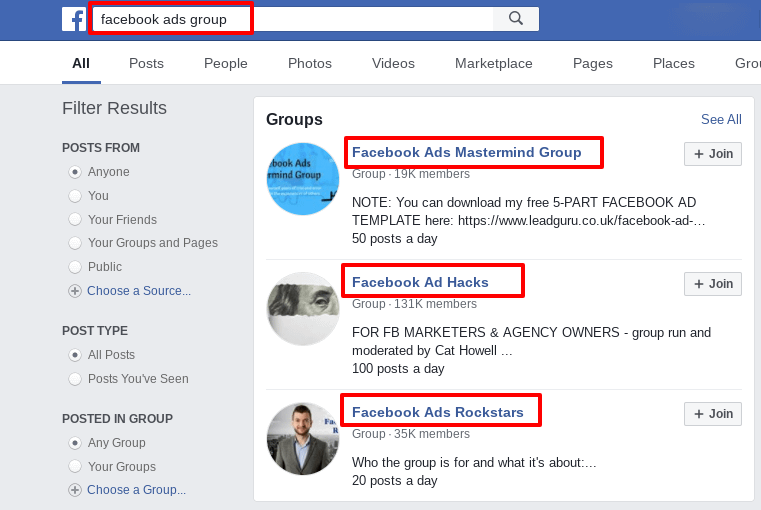
Finding contractors in Facebook Groups.
Now I’ve uncovered almost 180K FB ads enthusiasts.
Step 2: Research each group and make sure to read the rules. Make sure it won’t be a problem for you to network with individuals in the group. For example, in this groups’ rules below, they specifically forbid job offer posts, so this one would probably be a dead end for you.
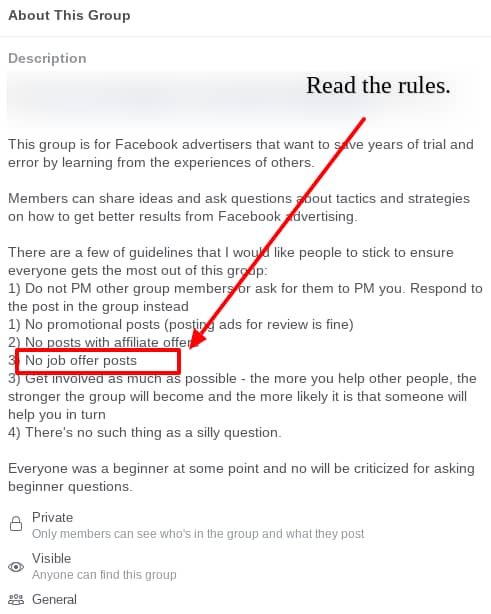
Make sure to read the FB group rules before applying.
Step 3: Join the groups that are most relevant for your search.
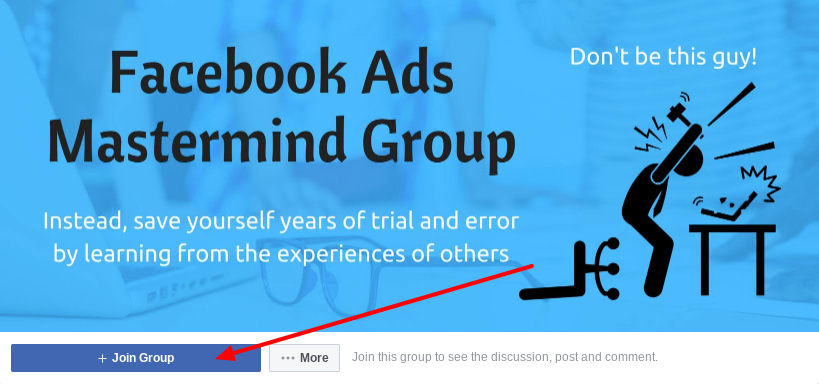
Find relevant Facebook groups.
Pro tip: Scroll down the page and make sure the groups are actually active. There should be posts happening daily, if it looks like a dead community, find something else and move on.
Step 4: Once you’ve been accepted into the group start networking and looking for potential talent to work with.
You’ll find posts like this occasionally and the experts will start showing themselves:
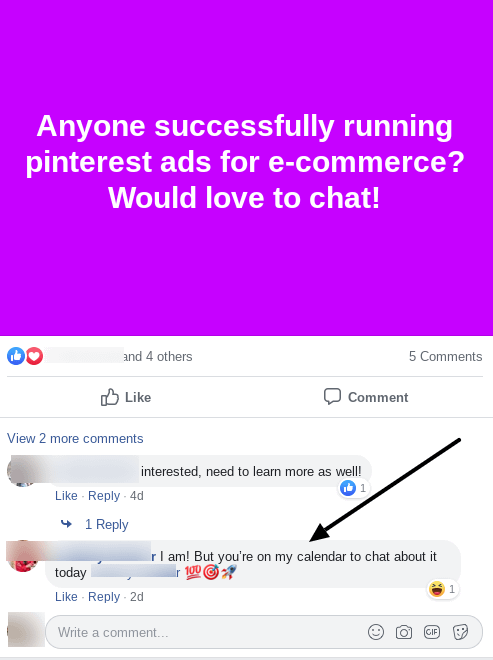
Start looking for experts and networking with them.
Step 5: Connect with potential talent, let them know what you’re looking for, get reviews and start calling their references.
Within short order you should have a list of potential contractors that you can start working with.
Outsourcing websites
Next on our list of best places to find outsource help are online outsourcing marketplaces like Upwork.com.
These sites have done all the hard work of putting together a marketplace of freelancers and built the infrastructure you need to find, hire, and pay them.
Most of the risk involved with paying people online for work and the labor required for sourcing talent has been eliminated by these sites, so they’re a great place to find individuals to help with your projects, especially if you have limited time available to you.
Here’s a few of our favorite places to find freelancers online to outsource your work:

Freelancer.com
Freelancer.com is exactly what it sounds like: a global marketplace for outsourced talent of all kinds. You can find almost anything you want here, including writers, accountants, and much more.

Upwork.com
Similar to Freelancer.com, Upwork is on-demand outsourced talent in an easy to use marketplace-style website interface. Their built-in tools make it easy to manage your team.
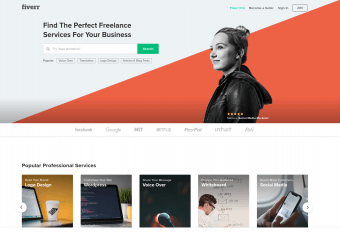
Fiverr
Fiverr is a massive marketplace of micro-service providers that claims to have the largest database of freelance talent. You can hire freelancers for almost online service with tasks starting at $5.
6. Get a Partner
One of the best ways to start growing your business is to find a business partner with complementary skills, or skills that fill gaps in your own services.
Entering into a partnership is no light undertaking.
You’re essentially agreeing to start a business together. Even if you’re agreement is informal, you’ve now opened yourselves up to the realities of a shared business.
Who you choose to partner with will have an enormous impact on your business, in fact, this could be one of those “Make It or Break It” decisions.
If you start a partnership with the wrong person, you could be at risk of losing your business and reputation.
So before entering into any partnership make sure to vet your potential partners, confirm that they are trustworthy with great references, and have the skills needed to get the job done.
When vetting your potential partners we recommend at the very least:
- Call their references.
- Carefully vet past work and client relationships.
- Get a sense of their working style and if they fit well with yours (cultural fit).
- Get a sense of their leadership style as they may be in leadership situations.
Signs you might be ready to get a partner
Are your current clients coming to you for additional marketing services but you’re turning them away because you don’t have the required skill set or outsourced partner?
That’s a big sign it might be time to take on a partner.
Let’s go through a few more...
Sign # 1. There’s a big hole in your business
Is there a massive component of your business that you’re consistently struggling to keep up with? Something lacking that is so fundamental and important to your continued growth and stability and you’re unable to fill the void yourself?
It could be that you simply can’t devote any time yourself to sales and marketing, or you can’t keep up with the accounting and finances, or it could be that the account side of your business is constantly suffering and your clients are unhappy with the service side of your business.
That’s a huge sign it could be time to find your perfect Sales Guru, CFO-type, or someone who’s amazing at client retention to fill that void.
Sign # 2. You’re sick of going it alone
If you’re the extroverted type and don’t thrive in a solo/remote environment where you’re constantly isolated and the sole focal point for your business, it could be a great time to look for a partner who can help be a buffer for the business and help motivate you to greater things.
Building a freelance business is isolating:
You’re in charge of everything, and the buck always stops with you. That means you rarely have a buffer between yourself and your clients and total failure.
A partner could be exactly what you need to re-invigorate your interest in the business and help redistribute responsibility - taking a ton of weight off your shoulders.
Sign # 3. You’re considering converting to an agency
Maybe you’re considering converting to an agency... in which case you’re going to love our next section in this guide, which is completely devoted to switching your freelance business to an agency.
A super power move for you at this stage - and a way to start positioning yourself for agency greatness - would be to bring on a partner now.
An agency has massive responsibilities that a solo freelancer just doesn’t have to deal with:
- Hiring/Firing
- Clients and Account Relations
- Finances and Taxes
And on and on...
You might not be the right person to manage all this stuff in your new agency, in fact, if you try and tackle it all you’ll probably become a huge bottleneck for growth.
Bringing on a talented operations person to fill the Chief Operating Officer spot, or a great finance person for your CFO could be the power positioning move you need to make the leap from solo freelancer to marketing agency.
7. Scale into an Agency
Next on our list is converting your business into an agency model.
A marketing agency works on behalf of their clients to create their campaigns and manage the day-to-day of their marketing efforts.
Agencies follow relatively time-honored business structures so there's no reason to reinvent the wheel with an agency if that's the route you choose.
A marketing agency can specialize in very niche subjects, or can be more generalist, performing a wide variety of marketing specialties across multiple industries.
Of course, if you've read our chapter on finding your niche as a freelance digital marketer, you'll know that we advocate for targeting a specific niche for your business.
So if you followed that advice, you may be positioned to create a niche marketing agency.
The agency business model typically includes senior leadership and ownership and the account team, which consists of the account manager(s), and anyone who is directly involved on a specific client's campaign.
Agencies typically employ multiple specialists that have been hired to perform specific tasks; email marketing specialists might be tasked with managing clients’ email campaigns, while media buyers might be brought on to manage the PPC campaigns.
An agency is a natural evolution that many freelancers choose because it is a simple way to expand your business.
If you're already managing multiple clients converting into an agency model may be as simple as bringing on somebody who can handle the customer service and accounts side, somebody who can handle the financial side, somebody who can handle the client acquisition and sales side, and one or two specialists to fill the specialty gaps and then assigning those new team members to an account.
The 7 Signs You Should Move to an Agency Model
- 1You are turning away clients
- 2Your business is plateauing
- 3Referrals and word of mouth are coming in
- 4You are regularly outsourcing work to specialists
- 5You’ve productized your offerings
- 6You’re the main bottleneck to your business
- 7Your clients are asking for other services or better account management
Bonus Scaling Tactic: Add other sources of revenue
Going back to your value ladder:
Have you found all the different ways that you can generate more revenue from your clients?
If not, in this section we’ll go over a few potential ideas to add new revenue streams.
Do you find yourself consistently recommending various products to your clients?
If so, then one way you can start building other sources of revenue is by getting your clients to sign up for products via affiliate links.
Affiliate Marketing
Affiliate marketing is simply a way to earn commissions from product owners by recommending their product or service to a new customer, and when they go through your link and buy that service or product, you get a commission.
For example if you’re building websites for your clients as a freelancer you could use affiliate links to set up hosting, buy domain names, buy WordPress themes, and marketing software like email marketing tools.
Tons of software companies have affiliate programs that pay recurring lifetime commissions, making them a great opportunity to slowly build passive income into your business.
There's a ton of affiliate programs out there for almost every single niche and every single product category - and you can easily uncover them with a few Google searches.
Here’s how:
1. Search for “[industry or product name] + affiliate programs” in Google. For example:
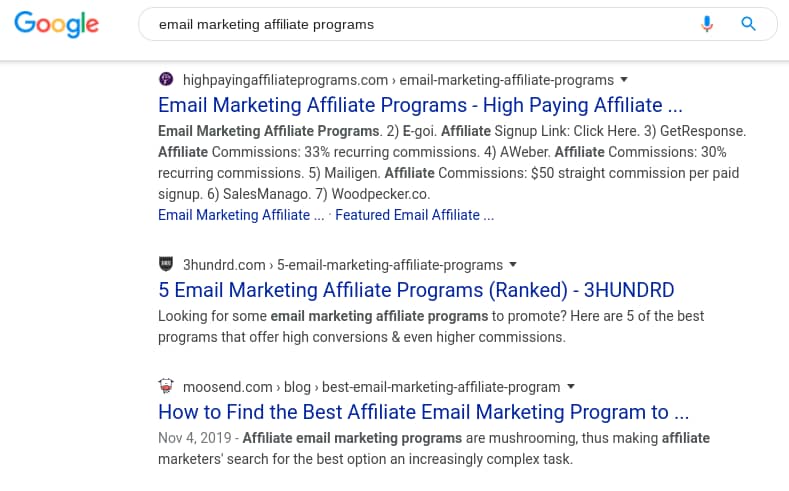
How to find affiliate programs to scale your freelance business.
2. Look for products and programs from reputable programs and sign up for that program.
3. Once you’re in the affiliate program, find your affiliate links and give the link to your client to sign up for the product, and that’s it!
You’ll get commissions every time someone signs up through your link.
Note: make sure to only recommend valuable, reputable products to your clients.
In fact, Thrive Themes has an affiliate program (you can sign up here), so if you find yourself consistently recommending Thrive Themes products to your clients, then you can actually earn commissions from us for recommending our products to your clients.
Sell Information Products
Do you find yourself constantly training your clients employees, or consulting for their team?
A great way to add a new layer of revenue with your clients could be by building an online course to offset your consulting activities.
Courses are a fantastic way to deliver high-level training at scale.
For example, if you’re consulting with sales teams... you might build a course that teaches your clients how to do high ticket sales on LinkedIn and charge $XX amount of dollars for them to enroll their entire sales team.
You can deliver the entire course via an online training zone with a tool like Thrive Apprentice, host your videos on YouTube or Vimeo, and add a new revenue stream that’s way more scalable than in person consulting.
At Thrive Themes, since we’re focused on building tools for online businesses, we’ve put together an amazing course on... building online courses, you can check it out at the link below and sign up for the wait list if it's not currently open for new enrollments:
Visit Course Craft Here
Tools to scale your freelancing business

No guide we could put together on scaling a business would be complete if we didn't cover various tools to help you grow that business.
We've already covered a ton of tools for your freelancing business across various chapters of this guide that can impact other areas of your business.
For example, if you're looking for invoicing and payment tools, check out the pricing chapter of this guide.
So in this section, we’ll be covering a few tools to help you grow the marketing side of your business and capture new leads and traffic and to create high converting website and client acquisition funnel.
NOTE: if you’re looking for client acquisition strategies, check out this chapter of the guide where we go into actionable strategies for bringing on more freelance clients.
Thrive Suite, Thrive Architect, and Thrive Leads
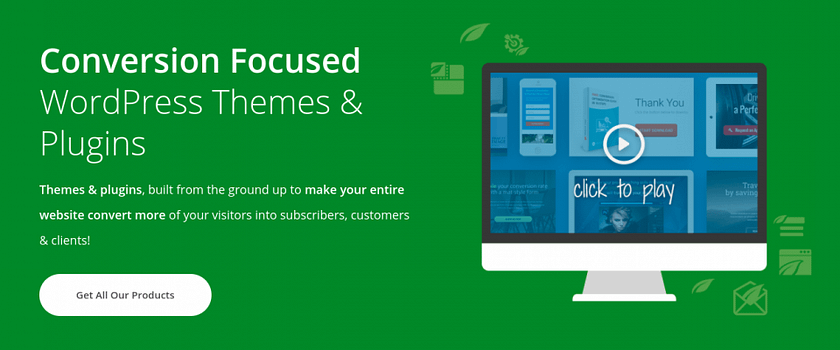
The Thrive Suite is the perfect tool for agencies and freelancers that have multiple client website projects to work on and also need dedicated tools to help grow their own business.
Thrive Themes isn’t just about building WordPress sites... it’s a suite of tools and plugins to build high-converting WordPress sites and pages, and to give you all the marketing tools you need to grow a business or website using WordPress.
Thrive Suite includes access to every Thrive product including Thrive Architect, Thrive Leads, and all our themes and gives you a license to install and use them on up to 20 seperate sites (perfect for an agency).
Thrive Architect let’s you build beautifully designed WordPress pages so you’re no longer confined by the native WordPress page-building functionality, and Thrive Leads gives you everything you need to capture and convert site traffic with a ton of lead generation tools for your sites.
All together, the Thrive Suite of tools is perfectly suited for growing your clients websites, and scaling your own sites.
Check out Thrive Suite here
Appointment Setting Tools

Automating your lead generation activities can be a huge burden off of your business and sales team.
We cover lead generation tactics for freelancers in detail in the Client Acquisition chapter of this guide, but in case you missed that, it's worth a mention here as well.
Using appointment setting tools like Calendly.com, you can automate away a big chunk of your appointment setting activities off of your shoulders, and using Thrive Theme landing page templates, you can easily set up an entire appointment setting funnel.
We go over how to build an automated online scheduling system using tools like Calendly and Thrive Themes on this post here.
Appointment Setting Tools

Simple landing pages and sales funnels can give you a massive edge over your competition and put you on the path to systematic scaling... and there’s no faster way to build high-converting landing pages on WordPress than Thrive Architect.
Landing pages are “single purpose web pages,” designed to help the viewer accomplish ONE task, or make ONE decision.
Likewise, a sales funnel is a series of pages that have the same purpose.
By focusing on one end goal - versus multiple objectives like a traditional website - you’re actually helping your visitors and customers accomplish their objectives easier and faster.
You can set up funnels and landing pages to accomplish a ton of tasks that can help you grow:
And so much more... the opportunities with these pages are endless and go beyond just sales and marketing.
You can also use landing pages to help your current clients make informed decisions about your services and products and improve retention rates by taking the burden off your accounts team.
Fortunately, Thrive Themes has been built from the ground-up to provide amazing landing page options and templates for entrepreneurs for everything from lead generation pages to webinar pages.
You can also take advantage of our free mini course on building and deploying landing pages:
View the Rapid Landing Page Development course.
Conclusion - Where Will You Take Your Freelance Digital Marketing Business?
Congratulations!
This concludes the Ultimate Guide on Freelance Digital Marketing, you’ve made it to the end... we hope you’ve found it valuable!
You’ve learned:
- How To Choose Your Niche
- How To Price Your Freelance Marketing Business
- How To Get Freelance Marketing Clients
- How To Manage Your Freelance Business Like A Pro
- How To Keep Your Clients Happy
- How To Grow Your Freelance Marketing Business
Hopefully by now you’re on your way to scaling your business to new heights and you’ve got a bag of new tricks for your freelance business!
Here at Thrive Themes our goal is always to provide exceptional content, amazing marketing and WordPress tools, and to help you on your journey to propel your business to unheard of heights.
If you’re looking for more awesome content like this, you can check out our Ultimate Guide on How To Start an Online Business, subscribe to our YouTube where we’re putting out tons of great content, or browse through all of our content on our Blog.
Thanks for reading and we all wish you the best in your freelance career here at Thrive Themes!
Share this ultimate guide on your social media account with the buttons above.
Disclaimer: Nothing on this page, our website, or any of our content or courses is a promise or guarantee of results. All the material within ThriveThemes.com is provided for information purposes only and we are not implying you'll duplicate any results. Your results will vary and depend on many factors. All business entails risk and no action should be taken solely based on the information in ThriveThemes.com. The publisher is not entering into any kind of practitioner/client relationship with its readers. The publisher is not responsible for errors or omissions.
This site is not a part of the Facebook website or Facebook Inc. Additionally, This site is NOT endorsed by Facebook in any way. FACEBOOK is a trademark of FACEBOOK, Inc.
Copyright 2019 by whitesquare GmbH, Thrive Themes | Contact | Privacy | Disclaimer